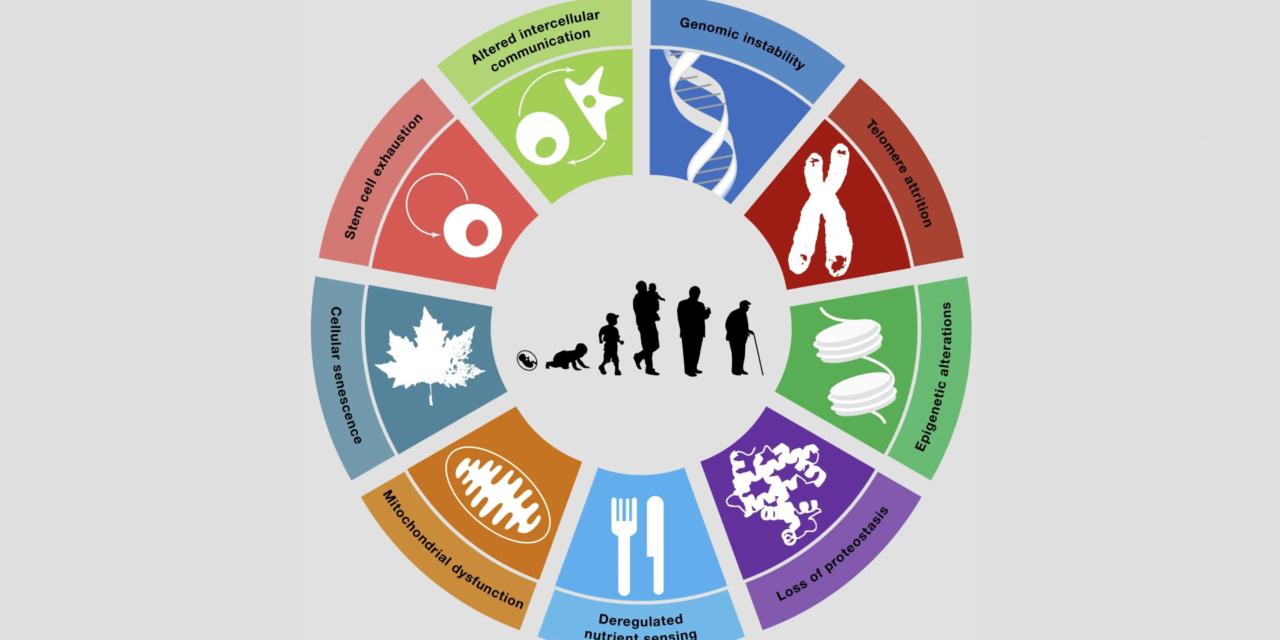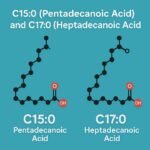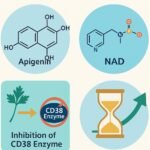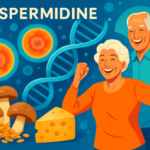Introduction :-
Aging is a natural process that every living organism undergoes. It’s marked by a gradual decline in physiological functions, leading to increased vulnerability to diseases and ultimately death. Scientists have identified several hallmarks of aging, one of the most critical being genomic instability. But what exactly is genomic instability, and why does it play such a significant role in the aging process?
Understanding Genomic Instability :-
Genomic instability refers to an increased tendency of the genome to acquire mutations when compared to normal. This instability can manifest as point mutations, deletions, insertions, or chromosomal rearrangements. It’s a hallmark of aging because the accumulation of genetic damage over time leads to a decline in cellular function and increased disease susceptibility.
1.How Genomic Instability Occurs
Genomic instability occurs when the DNA within our cells is damaged and not correctly repaired. Our cells are constantly exposed to damaging agents, both internal (like metabolic byproducts) and external (like UV radiation). When DNA repair mechanisms fail to correct this damage accurately, it results in genomic instability.
2.Impact on Cells
The impact of genomic instability on cells is profound. It can lead to cell death, malfunction, or uncontrolled cell division, contributing to aging and various diseases, particularly cancer.
Causes of Genomic Instability :-
1.DNA Damage and Repair Mechanisms
DNA damage is a primary cause of genomic instability. Our cells have evolved complex mechanisms to repair this damage, but these systems are not infallible. When they fail, mutations accumulate, leading to genomic instability.
2.Environmental Factors
Environmental factors such as radiation, pollution, and exposure to toxic chemicals can cause DNA damage. These agents introduce mutations that the body sometimes cannot repair, leading to genomic instability.
3.Lifestyle Factors
Lifestyle choices, including diet, smoking, and alcohol consumption, can influence genomic stability. Poor lifestyle choices can increase the production of free radicals, which cause oxidative DNA damage.
Mechanisms of DNA Damage :-
1.Types of DNA Damage
DNA can suffer from various types of damage, including single-strand breaks, double-strand breaks, crosslinking, and base modifications.
2.Oxidative Stress and DNA Damage
Oxidative stress, caused by an imbalance between free radicals and antioxidants in the body, is a significant source of DNA damage. Free radicals attack DNA, leading to mutations.
3.Role of Free Radicals
Free radicals are highly reactive molecules that can damage DNA, proteins, and lipids. They are produced naturally in the body but can be increased by external factors like pollution and smoking.
DNA Repair Pathways :-
1.Base Excision Repair
This pathway fixes small, non-helix-distorting base lesions caused by oxidation, alkylation, or deamination.
2.Nucleotide Excision Repair
This mechanism repairs bulky, helix-distorting lesions, like those caused by UV light.
3.Mismatch Repair
This system corrects errors that escape the proofreading activity of DNA polymerases during DNA replication.
4.Double-Strand Break Repair
Double-strand breaks are among the most severe types of DNA damage. They are repaired by two main pathways: homologous recombination and non-homologous end joining.
Genomic Instability and Cellular Aging :-
1.Telomere Shortening
Telomeres protect chromosome ends but shorten with each cell division. When they become too short, cells can no longer divide, leading to cellular aging and senescence.
2.Cellular Senescence
Senescent cells stop dividing but remain metabolically active, often secreting harmful substances that can damage nearby cells and tissue.
3.Apoptosis
Severe genomic instability can trigger apoptosis, or programmed cell death, as a mechanism to prevent the propagation of damaged cells.
Genomic Instability and Age-related Diseases :-
1.Cancer
Cancer is fundamentally a disease of genomic instability. Mutations in oncogenes and tumor suppressor genes drive cancer development and progression.
2.Neurodegenerative Diseases
Diseases like Alzheimer’s and Parkinson’s are linked to genomic instability. DNA damage and faulty repair mechanisms contribute to the neuronal death seen in these diseases.
3.Cardiovascular Diseases
Genomic instability also plays a role in cardiovascular diseases, such as atherosclerosis and heart failure, by contributing to the dysfunction of endothelial cells and smooth muscle cells in blood vessels.
Role of Genomic Instability in Cancer :-
1.Oncogenes and Tumor Suppressor Genes
Mutations in oncogenes can lead to uncontrolled cell division, while mutations in tumor suppressor genes result in the failure to control cell growth, both of which contribute to cancer.
2.Mutations and Cancer Development
Accumulated mutations from genomic instability can activate oncogenes or deactivate tumor suppressor genes, driving cancer progression.
Genomic Instability in Neurodegenerative Diseases :-
1.Alzheimer’s Disease
In Alzheimer’s disease, DNA damage contributes to the accumulation of amyloid-beta plaques and tau tangles, hallmark features of the disease.
2.Parkinson’s Disease
Parkinson’s disease involves the loss of dopaminergic neurons, with DNA damage playing a crucial role in this neuronal death.
Genomic Instability and Cardiovascular Diseases :-
1.Atherosclerosis
DNA damage in endothelial cells can lead to the development of atherosclerotic plaques, contributing to heart disease.
2.Heart Failure
Genomic instability can impair the function of cardiac muscle cells, leading to heart failure.
Strategies to Mitigate Genomic Instability :-
1.Antioxidants
Antioxidants neutralize free radicals, reducing oxidative stress and DNA damage. Foods rich in antioxidants, like fruits and vegetables, can help maintain genomic stability.
2.Lifestyle Changes
Healthy lifestyle choices, such as regular exercise, a balanced diet, and avoiding smoking and excessive alcohol, can reduce the risk of DNA damage.
3.Pharmacological Interventions
Drugs that boost DNA repair mechanisms or reduce oxidative stress are being explored as potential treatments to maintain genomic stability.
Future Research and Innovations :-
1.Gene Therapy
Gene therapy aims to correct defective genes responsible for genomic instability, offering potential treatments for age-related diseases.
2.CRISPR Technology
CRISPR technology allows for precise editing of the genome, which could be used to fix mutations and reduce genomic instability.
3.Advances in Biotechnology
Ongoing advancements in biotechnology promise new ways to understand and combat genomic instability, potentially extending healthy lifespan.
The Importance of Genomic Stability in Longevity :-
1.Promoting Healthy Aging
Maintaining genomic stability is crucial for promoting healthy aging and reducing the risk of age-related diseases.
2.Genetic Factors in Long-lived Individuals
Studies of long-lived individuals have shown that genetic factors contributing to efficient DNA repair and genomic stability are key to their longevity.
Conclusion :-
Genomic instability, the tendency of the genome to undergo alterations in DNA content through mutation, is a central feature of the aging process. As cells age, chromosomes lose their stability, leading to an accumulation of genetic and epigenetic changes.
These changes include:
- Telomere shortening
- Increased DNA damage and decreased DNA repair capacity
- Epigenetic alterations such as changes in DNA methylation patterns and chromatin organisation
- Accumulation of somatic mutations and chromosomal abnormalities
The simultaneous occurrence of these genomic and epigenomic alterations contributes to overall cellular dysfunction and organismal decline, increasing susceptibility to age-related diseases like cancer, cardiovascular disease, and neurodegeneration.While the exact mechanisms linking genomic instability to aging are complex and not fully understood, continued research in model organisms and human cells has provided strong evidence that genomic instability is a fundamental driver of the aging process. Interventions aimed at reinforcing DNA repair and genome surveillance may hold promise for slowing down the onset of aging and age-related diseases.










